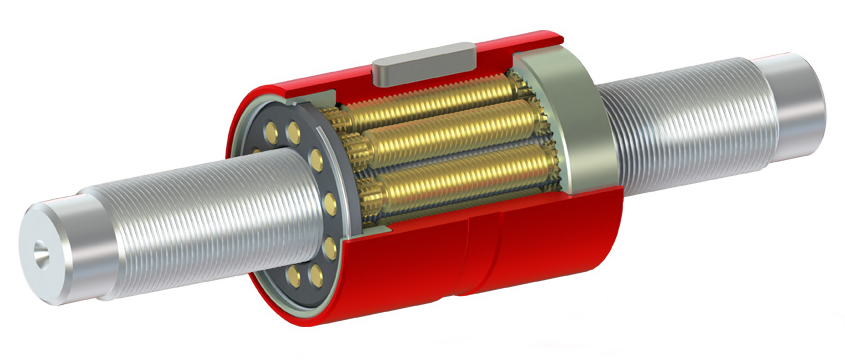Traditional roller screws — sometimes referred to as planetary roller screws — can produce axial forces comparable to hydraulic cylinders, with the speed and precision capabilities of ball screws, at a price point that falls between the two. A variation of the planetary roller screw — referred to as a differential roller screw — reduces some of the complexity of the planetary design, without sacrificing load and speed capacity, and does so at a price point closer to that of a ball screw.
Traditional planetary roller screws rely on threaded rollers, referred to as planets, to transmit forces between the screw shaft and the nut. The rollers, screw shaft, and nut inner diameter have the same lead, so each rotation of the screw moves the nut a linear distance equal to the lead of the screw. (In screw terminology, the lead is the linear distance traveled per full rotation of the screw shaft.) The ends of the rollers, or planets, mesh with geared rings on each end of the nut, allowing the rollers to act like planets, spinning on their axes while revolving around the screw shaft.

In a traditional planetary roller screw, the rollers, screw shaft, and nut inner diameter all have the same lead, so with each revolution of the screw, the nut moves a linear distance equal to the lead of the screw.
Image credit: Rollvis SA
Differential roller screws are very similar to planetary roller screws, consisting of a threaded screw shaft, threaded rollers, and a nut. However, for a differential roller screw, the inner diameter of the nut does not have a lead (threads). Instead, it has grooves at each end. The rollers also differ from those used in planetary design. Instead of a constant pitch diameter, rollers for differential screws have a varying pitch diameter — larger in the middle, where the roller engages with the screw shaft, and smaller on the ends, where the roller engages with the grooves of the nut. This variance in pitch diameter between the roller-screw engagement and the roller-nut engagement means the nut travels at a different rate than the screw, hence the term “differential” roller screw.

In a differential roller screw, the rollers have a larger pitch diameter in the middle, and the nut has only grooves (no threads). Because the pitch diameter of the roller-screw interface is different than the pitch diameter of the roller-nut interface, the speed of the nut differs from the speed of the screw – hence, the term “differential roller screw.”
Image credit: Scheaffler
Differential roller screws can be thought of as planetary roller screws with “built-in” gearing.
Although the nut inner diameter isn’t threaded, the large contact area (more contact points, with line contact) between the screw shaft and the rollers gives differential roller screw assemblies high load capacity. And their design is simpler and easier to manufacture than that of a planetary roller screw, so differential roller screws can be offered at a lower price point than planetary designs. However, this design also makes them subject to slipping, so position feedback is typically recommended for applications that use differential roller screws.
The post What are differential roller screws and how do they differ from planetary designs? appeared first on Linear Motion Tips.